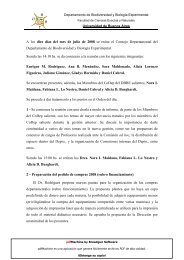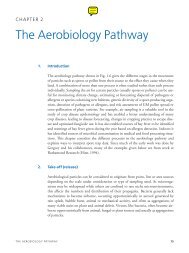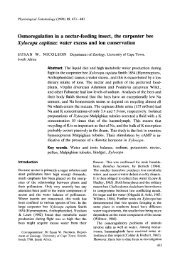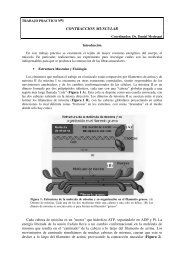Role of WUSCHEL in Regulating Stem Cell Fate in the Arabidopsis Shoot Meristem
Role of WUSCHEL in Regulating Stem Cell Fate in the Arabidopsis Shoot Meristem
Role of WUSCHEL in Regulating Stem Cell Fate in the Arabidopsis Shoot Meristem
You also want an ePaper? Increase the reach of your titles
YUMPU automatically turns print PDFs into web optimized ePapers that Google loves.
<strong>Cell</strong><br />
806<br />
regulators <strong>of</strong> shoot and floral meristems, suggest<strong>in</strong>g<br />
that WUS <strong>in</strong>tegrates positional and temporal <strong>in</strong>formation<br />
from <strong>the</strong>se genes (Laux et al., 1996; Laux and Scho<strong>of</strong>,<br />
1997).<br />
Here, we report <strong>the</strong> molecular analysis <strong>of</strong> <strong>the</strong> WUS<br />
gene, address<strong>in</strong>g its role <strong>in</strong> shoot and floral meristems.<br />
Our data support a novel model to expla<strong>in</strong> how <strong>the</strong>se<br />
meristems are formed and ma<strong>in</strong>ta<strong>in</strong>ed <strong>in</strong> plant development.<br />
We provide evidence that <strong>the</strong> specification <strong>of</strong> stem<br />
cells requires a small group <strong>of</strong> underly<strong>in</strong>g cells that exhibit<br />
WUS expression. This cell group orig<strong>in</strong>ates dur<strong>in</strong>g<br />
early embryo pattern formation long before a shoot meristem<br />
can be recognized.<br />
Results<br />
Map-Based Clon<strong>in</strong>g <strong>of</strong> <strong>the</strong> WUS Gene<br />
To isolate <strong>the</strong> WUS gene, we used RFLP- and PCRbased<br />
mapp<strong>in</strong>g <strong>of</strong> recomb<strong>in</strong>ation breakpo<strong>in</strong>ts <strong>in</strong> 3150<br />
meiotic events from a cross <strong>of</strong> wus-1 (Ler) � wild type<br />
(Nd). We determ<strong>in</strong>ed <strong>the</strong> order <strong>of</strong> genomic loci as ABI14-<br />
GII, pCITd84, m216, WUS, and PhyB and localized WUS<br />
about 0.8 cM proximal to <strong>the</strong> RFLP marker pCITd84<br />
(Figure 2A). We <strong>in</strong>itiated a chromosome walk from<br />
pCITd84 with yeast artificial chromosomes (YAC) and<br />
localized WUS on a s<strong>in</strong>gle YAC clone <strong>of</strong> about 400 kb,<br />
yUP3C8. From <strong>the</strong> right end <strong>of</strong> this YAC, we <strong>in</strong>itiated a<br />
cosmid walk spann<strong>in</strong>g about 52 kb and mapped <strong>the</strong><br />
WUS gene to this contig (Figure 2A).<br />
To fur<strong>the</strong>r localize <strong>the</strong> WUS gene, we transformed<br />
cosmids represent<strong>in</strong>g this contig <strong>in</strong>to roots <strong>of</strong> homozygous<br />
wus-1 seedl<strong>in</strong>gs and exam<strong>in</strong>ed <strong>the</strong> regenerated<br />
transgenic plants for complementation. The seedl<strong>in</strong>gs<br />
had been obta<strong>in</strong>ed from a cross <strong>of</strong> wus-1 (Ler) � wild<br />
Figure 1. <strong>Shoot</strong> and Floral <strong>Meristem</strong> Development type (Ws-2), which enabled us to confirm <strong>the</strong>ir genotype<br />
(A) Organization <strong>of</strong> <strong>the</strong> shoot meristem. The tissues <strong>of</strong> <strong>the</strong> plant at <strong>the</strong> WUS locus by PCR for <strong>the</strong> closely l<strong>in</strong>ked markers<br />
shoot are derived from three germ layers <strong>of</strong> <strong>the</strong> shoot meristem,<br />
m216 and yUP3C8 right (Figure 2A). Roots taken from<br />
L1–L3 (arrows). Each layer presumably conta<strong>in</strong>s 1–3 stem cells (sc,<br />
darkly shaded) with<strong>in</strong> <strong>the</strong> apical part <strong>of</strong> <strong>the</strong> central zone (CZ, fa<strong>in</strong>tly 14 seedl<strong>in</strong>gs that were transformed with cosmids 6, 8,<br />
shaded). Organ primordia (p) are <strong>in</strong>itiated <strong>in</strong> <strong>the</strong> peripheral zone (PZ, or 9 (Figure 2A) gave rise to a total <strong>of</strong> 76 transgenic<br />
hatched). Underneath <strong>the</strong> CZ, <strong>the</strong> flat cells <strong>of</strong> <strong>the</strong> rib zone (RZ, plants that showed complementation <strong>of</strong> <strong>the</strong> wus defect<br />
horizontal stripes) form <strong>the</strong> central pith <strong>of</strong> <strong>the</strong> shoot axis. and formed flowers with a complete set <strong>of</strong> organs (Figure<br />
(B and D) Live seedl<strong>in</strong>gs. (B) Wild-type seedl<strong>in</strong>gs give rise to a<br />
2B). By contrast, all transgenic plants conta<strong>in</strong><strong>in</strong>g any <strong>of</strong><br />
rosette <strong>of</strong> leaves. (D) wus seedl<strong>in</strong>g apices discont<strong>in</strong>ue leaf formation<br />
<strong>the</strong> o<strong>the</strong>r cosmids showed <strong>the</strong> wus mutant phenotype.<br />
after two true leaves have been formed. c, cotyledon; l, leaf.<br />
(C and E) Scann<strong>in</strong>g electron micrographs <strong>of</strong> flowers. (C) Wild-type The progeny <strong>of</strong> <strong>the</strong> plants that showed complementation<br />
flowers conta<strong>in</strong> four whorls <strong>of</strong> organs: four sepals <strong>in</strong> <strong>the</strong> first, four segregated WUS and wus phenotypes. All <strong>of</strong> 338 kana-<br />
petals <strong>in</strong> <strong>the</strong> second, six stamens <strong>in</strong> <strong>the</strong> third, and two fused carpels myc<strong>in</strong>-resistant plants tested exhibited a wild-type phe<strong>in</strong><br />
<strong>the</strong> fourth whorl. (E) wus flowers, which are occasionally formed notype, <strong>in</strong>dicat<strong>in</strong>g that <strong>the</strong> T-DNA that conferred kanaon<br />
adventitious shoots, display normal organ numbers <strong>in</strong> <strong>the</strong> two<br />
myc<strong>in</strong> resistance also carried <strong>the</strong> WUS gene (data not<br />
outer whorls but term<strong>in</strong>ate <strong>in</strong> a s<strong>in</strong>gle central stamen.<br />
Scale bars, 1 mm (B and D) and 500 �m (C and E).<br />
shown).<br />
The three complement<strong>in</strong>g cosmids shared two H<strong>in</strong>dIII<br />
DNA fragments <strong>of</strong> 10 and 1.5 kb, respectively. With <strong>the</strong>se<br />
fragments, we screened 5 � 105 Recent genetic analysis <strong>in</strong> <strong>Arabidopsis</strong> suggests a<br />
clones <strong>of</strong> a cDNA library<br />
central role for <strong>the</strong> WUS gene <strong>in</strong> regulat<strong>in</strong>g stem cell fate made from young flowers (Weigel et al., 1992) and isothroughout<br />
development. Mutations <strong>in</strong> <strong>the</strong> WUS gene lated seven <strong>in</strong>dependent cDNA clones, which repre-<br />
specifically result <strong>in</strong> <strong>the</strong> failure <strong>of</strong> shoot and floral meri- sented a s<strong>in</strong>gle transcript. Two clones displayed one<br />
stems to self-ma<strong>in</strong>ta<strong>in</strong> (Figures 1B–1E) (Laux et al., long open read<strong>in</strong>g frame <strong>of</strong> 873 nucleotides. We con-<br />
1996). Although <strong>in</strong> <strong>the</strong> absence <strong>of</strong> WUS, stem cells ap- firmed that this open read<strong>in</strong>g frame represented <strong>the</strong><br />
pear misspecified, <strong>the</strong>y are not <strong>in</strong>corporated <strong>in</strong>to or- WUS gene by identify<strong>in</strong>g mutations <strong>in</strong> <strong>the</strong> cognate geno-<br />
gans, <strong>in</strong>dicat<strong>in</strong>g that WUS is required to specify stem mic DNA <strong>of</strong> four different wus alleles (see below). Stop<br />
cell fate ra<strong>the</strong>r than to repress organ formation. Genetic codons upstream <strong>of</strong> this open read<strong>in</strong>g frame <strong>in</strong>dicated<br />
analysis <strong>in</strong>dicated that WUS <strong>in</strong>teracts with several o<strong>the</strong>r that <strong>the</strong>se cDNAs conta<strong>in</strong>ed <strong>the</strong> complete cod<strong>in</strong>g region.


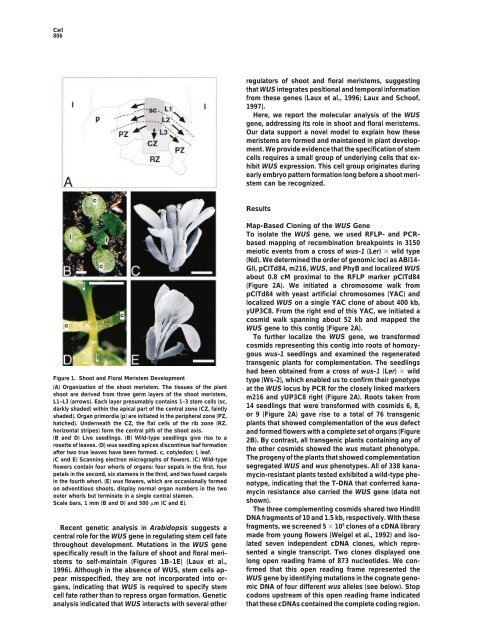
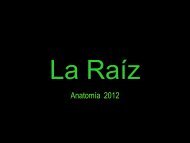
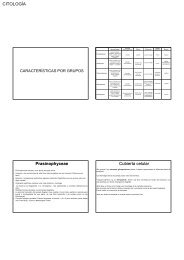


![Estructuras secretoras internas [4.64 MB]](https://img.yumpu.com/14294979/1/190x143/estructuras-secretoras-internas-464-mb.jpg?quality=85)
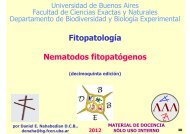
![anatomía y exomorfología [7.14 MB]](https://img.yumpu.com/12744163/1/190x143/anatomia-y-exomorfologia-714-mb.jpg?quality=85)
